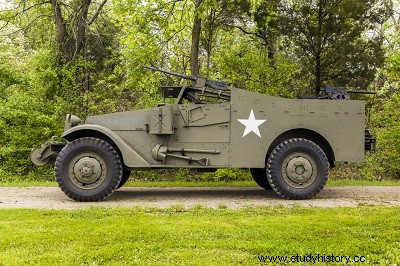
M3A 7; M7; M2; MZA 7; M3; M3A2 and variants
Type :reconnaissance vehicle.
Crew :8 men.
Armament :most often a .50 M1 machine gun and a 30 M1919A4 on skids at the rear of the hull.
Dimensions:
length :5.62 mi;
width :2.03 m;
height :2.11 m.
Weight in combat order :5.6 t.
Ground pressure :estimated at 4.22 kg/cm2.
Specific power :15.7 bhp.
Engine :Hercules JXD 6 cyl. in-line water-cooled, developing 87 hp at 2,400 rpm.
Performance:
road speed speed:88 km/h;
road range :400 km;
vertical obstacle :035 m;
ford :0.71 m;
slope :30%.
Service time :introduced in 1939 in the US Army as a reconnaissance and command vehicle. This type of machine was not the subject of any further research but served as a starting point for the development of the half-track.
In 1936, the M1A 1, now equipped with the radio and modified on other points of detail, was standardized under the designation of scout car M3. This vehicle had four-wheel drive, 12.7 mm armour, seats for eight men, a maximum road speed of 100 km/h. Skids on three sides of the open cockpit added to the versatility of the machine guns and the M3 entered as a troop carrier and reconnaissance vehicle for the 13th Cavalry Regiment, 7th Motorized Brigade, in 1938. At this time, the General Commanding Cavalry recommended the revision of the tables of equipment in all cavalry units and the replacement of all armored cars, half-tracked trucks and mortar carriers by scout cars.
The M3A1, standardized in 1939, perfectly embodied the concept of the scout car. We saw for the first time the roller at the front, which was to become a kind of trademark and which spared the vehicle from nose-diving in an excavation or on other obstacles. The machine also featured a wider body, new machine gun mounts, a new organization for crew seating and equipment storage. In 1939, the Ordnance Department had a policy of equipping all combat vehicles with diesel engines. As a result, a prototype of the M3A 1 received a diesel engine and was standardized under the designation M3A1. Despite the construction of 100 copies, the diesel policy was never fully applied and ended up being suspended in March 1942. The vehicles that came off the line were dismantled and the engines returned to the depot. Other experimental modifications included the fitting of a 37mm gun and some attempts to improve roof cover. The M3A1, produced in large quantities (20,918 examples), was one of the first vehicles made available by the Lend-Lease Act of 1941.
Many were delivered to Great Britain and Soviet Union; there is also a strong resemblance between the M3A1 and the post-war Soviet troop carrier BTR-40. In the British Army, American scout cars were used as ambulance command vehicles and troop carriers; in fact, they were rarely given reconnaissance missions. M3 series scout cars are still in service today in many Third World countries, including Brazil, Chile, Spain, Liberia and the Republic of Congo. For the American army, the M3A 7 marked the disappearance of wheeled vehicles in the field of pure reconnaissance, this role now being offered either to jeeps or to light tanks.
Nevertheless, research on the vehicle continued in other directions, of which here are some. The T13 scout car was essentially similar to the M3 Mormon-Herrington produced 38 mild steel plates for the National Guard in 1938. The T24 scout car, which mounted an armored body on a Willys 6x6, was manufactured by order of the commanding general of the tank destroyers and also used for the 37 mm self-propelled T14.
The T25 scout car represented a commercial initiative of the Smart company which wanted to provide the army with armor for the jeep. The Ordnance Department judged the vehicle too heavy and gave a negative opinion but the project was resumed and several attempts were made to improve the vehicle. But, as no way was found to avoid a significant overload on the suspension, the project was definitively thrown in the trash in September 1943. The Tl, observation post vehicle, was a small open armored vehicle, with four tractor wheels, by artillery. The T2, observation post vehicle, was similar to the Tl, but derived from the Ford GAJ 4x4 4x4 truck chassis, also used for the 37 mm T33 self-propelled and the 57 mm T44 self-propelled.
